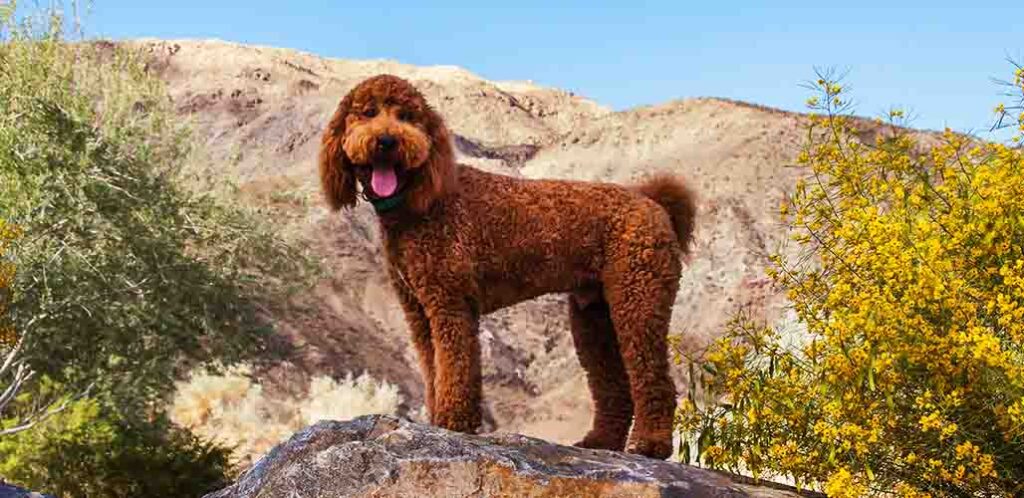Labradoodle history is a phenomenon unlike any other, and it has completely changed the dog breeding landscape. Labradoodles captured our imagination in the 1990s, and then exploded in numbers quicker than any canines that came before them. They started out as a mixed breed service dog for people with allergies, but they have become sought-after pets. Efforts are even underway to establish them as a new pedigree in their own right. The Labradoodle’s journey has not always been plain sailing however. The breeder who launched them into the world has since become their biggest detractor. So come with us for a journey through the history of Labradoodles, and a glimpse at what the future may hold!
Contents
- Labradoodle history: why and where it all began
- The first litter
- The development of Labradoodles over time
- Was it all a mistake?
- The Doodle today
- What does the future hold?
Labradoodle history: why and where it all began
What is the story behind Labradoodles? The first recorded use of the term Labradoodle was by 1950s speed record breaker and all-round daredevil Donald Campbell, in relation to his Lab Poodle cross Maxie. It’s likely he used the name whimsically, since his dog was just a mutt by the standards of the time.
The Labradoodle hybrid as we know it today started out as a breeding experiment commissioned by the Royal Guide Dog Association of Australia (now known as Guide Dogs Victoria). A blind lady living in Hawaii approached them about breeding a service dog which wouldn’t trigger her husband’s allergies. Due to Australia’s strict quarantine laws, a service dog bred and trained there would be able to start working as soon as it stepped off the plane in Hawaii. The charity tasked breeder Wally Conron with the mission of producing a suitable dog. Initially he focused on producing a purebred Poodle for the job. But, three years and 33 puppies later, none of them had a temperament which suited them to guide dog training. So, in 1989 Conron took a new tack – crossing a Poodle with a Labrador.
The first Labradoodle litter
The first Labrador Poodle cross litter Conron bred had just three puppies. Samples of their fur and saliva were dispatched to Hawaii, for testing on the allergic gentleman. Only one sample didn’t trigger his allergy symptoms. So that puppy, called Sultan, entered guide dog training for his wife.
But what to do with the other two puppies in the litter? Neither of them had the disposition for service work, so they were offered for adoption instead. But… no one wanted them. Back then, mixed breed puppies were regarded as second rate mutts, no matter how impressive their parents’ individual pedigrees. So a hasty rebranding exercise was launched to find them homes. For the second time, the name Labradoodle was coined, this time by Conron. The Guide Dog Association notified the local press about these clever, cuddly, curly puppies with a cute name looking for loving homes. The following day they were inundated with interest.

The development of Labradoodles over time
Following that first litter, the concept of the Labradoodle took off like wildfire, all around the world. By the new millenium they were as ubiquitous as cell phones, MySpace, and *NSYNC. By 2009, even the freshly-inaugurated Barack Obama was talking about getting one (although his family would eventually plump for a Portuguese Water Dog instead). The meteoric rise of first generation Poodle Labrador mix dogs had knock-on effects for the wider dog breeding community too:
- From the mid-1990s onward, some breeders started to pursue the idea of developing Labradoodles into a new breed in their own right. More on that in a moment.
- A plethora of other crossbreed puppies with portmanteau names began to appear, such as the Cockapoo, Pomsky, Schnoodle, Chug, and Chiweenie. Collectively these became known as designer dog breeds.
- A debate about the appropriateness of crossing different pedigree dogs began, which has rumbled on ever since. More coming up on that too.
By 2009 designer dogs were so numerous that the American Kennel Club changed their rules. Going forward, mixed breed dogs from pedigree parents would be eligible to receive an AKC identification number. They could also take part in a mixed breed class at some events. This was a huge shift for a major breed registry. And there’s little doubt it would never have happened, had it not been for the Labradoodle.
The Australian Labradoodle
Within a few years of the first Labradoodle litter, they were fast becoming the pet of choice for a new group of discerning dog-seekers. Many people specifically wanted an F1 cross, but some breeders were interested in the potential for Labradoodles to become a new pedigree dog breed in their own right. After all, most of the purebred dogs we know and love today once started out as crosses too. As their breeding project gained momentum, a new breed standard was drawn up, and a name was picked out: Australian Labradoodle, in honor of the country where their journey started. National breed clubs started to pop up, including the Australian Labradoodle Association of America (ALAA) in 2004, the World Australian Labradoodle Association (WALA) in 2018.
Australian Labradoodles gained further legitimacy in 2019 when the Orthopedic Foundation for Animals (OFA) started collecting health testing data for them. Over 15,000 Australian Labradoodles are OFA registered at the time of writing. And as of 2020, 88,000 Labradoodle dogs have been registered with the ALAA. Australian Labradoodles come in three sizes (Standard, Medium and Miniature), and two coats (wool and fleece). Their size, coat and temperament are more reliably consistent than that of an F1 or F2 Doodle. The stud book remains open, so ‘infusion’ litters with a non-Australian Labradoodle parent can still be registered, provided they meet strict criteria.
Was it all a mistake?
First generation and Australian Labradoodles are still prospering, but despite this, mixed breed dogs remain controversial. In 2019, Wally Conron made headlines when he revealed he had only bred a further 28 Labradoodle puppies for Guide Dogs Victoria. Even more explosively, he described them as ‘his life’s regret‘. Specifically, he was upset that Labradoodles’ success had made them popular with puppy farmers. Non-health tested parents with poor temperaments were being used as sires and dams. And they were producing puppies with genetic diseases and behavior problems. What’s more, despite only one third of Conron’s own puppies being hypoallergenic, breeders were guaranteeing all Doodles to be safe for allergy sufferers. In fact, there is no evidence to suggest that any dog breed is reliably non-allergenic.
Their pros and cons
Today, breeder, veterinarians, trainers, behaviorists and dog lovers are still make the case for and against breeding designer dogs. Here are some of the headline arguments against them:
- Cross breeding dogs produces unpredictable results in terms of both appearance and temperament. Puppies that don’t meet their owner’s expectations as they grow up are more likely to be abandoned – especially if they trigger allergies after all!
- Cross breed dogs have been a target for inexperienced breeders and puppy farms. Dogs from puppy farms are more likely to have long term health and behavioral problems.
- Some inherited diseases become more common in crossbreeds. For example F1 Labradoodles are diagnosed with retinal dysplasia more often than Labs or Poodles.
On the other hand:
- Cross breeding generally improves puppies’ health, by adding new genetic material to a stale gene pool, and reducing the risk of recessive diseases.
- Mixed breed dogs live longer, on average, than purebred dogs.
- Good and bad breeders exist in all areas of the dog community. Just as some breeders persist in breeding pedigree dogs with desperately poor health prospects, some Labradoodle breeders take their responsibilities extremely seriously.
Ultimately, it’s up to you to decide your own position on whether Doodles are a good idea, or not.
The Doodle today
Despite the controversy, Lab Poodle cross dogs remain extremely popular. Some Labradoodles still undertake guide dog training. Others volunteer as therapy dogs, or compete in dog sports like field trials, flyball and dock diving. But most Doodles are simply pets and family members. They have found homes all over the world. Including with celebrities such as golfer Tiger Woods and supermodel Christie Brinkley. If a Labradoodle is on your shortlist, here are some things you need to think about:
- First generation Labradoodles are highly variable. Are you ready for that, or would you be better off with an Australian Labradoodle?
- Not all Labradoodles are (nor ever have been) hypoallergenic. If someone in your household has allergies, work with a breeder to find a puppy who doesn’t trigger their symptoms. Be wary of any breeder who claims that all their dogs are non-allergenic. They are either unforgivably naive or deliberately misleading you.
- If your Labradoodle’s coat doesn’t shed, it will need brushing daily and clipping every 6-8 weeks.
- Learn the signs of a puppy farm, and research breeders carefully. Insist on seeing proof of health testing before meeting a litter. A common tactic is to stall over providing evidence until you’ve met the puppies and formed an emotional attachment to them.
What does the future hold?
Labradoodles have triggered an unprecedented change in how we breed dogs, and what people look for in a pet. For now at least, it seems that first generation crosses are here to stay. As for the Australian Labradoodle, as long as the stud book remains open, they remain ‘unfinished’. Already, traits specifically excluded by their breed standard – like merle coats – are still gaining their own cult following. Will we see more splinter breeds compete to get established? Only time will tell!
Labradoodle history – summary
Some events of the past are shrouded in mystery. But the Labradoodle is a thoroughly modern dog breed. We’re lucky that historical records of how they came to be, including testimonials from the people involved, are widely available. What started out as a small-scale breeding project with a very specific purpose exploded in a way that no one could have ever predicted. Labradoodle history has taken them from bespoke service dog, to companion dog for the masses. However you feel about them, let us know in the comments box down below!

